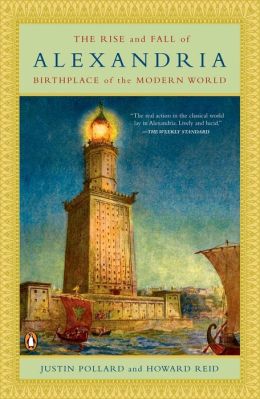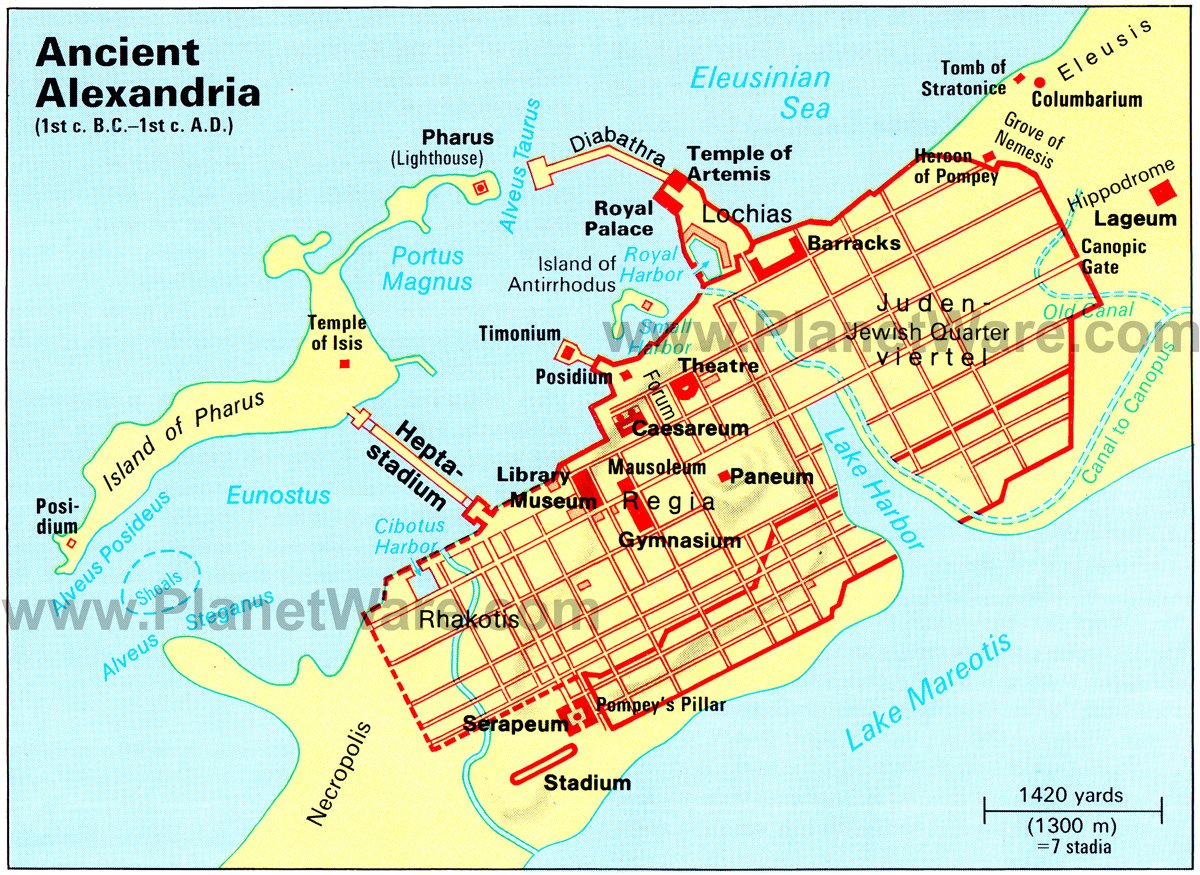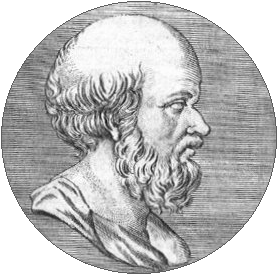The History Book Club met last night at the Kensington Row Bookshop in spite of the impending snow event. Elisenda Sola-Sole, the owner operator of the shop, very kindly offered to keep the shop open to meet our needs. We began at 7:00 pm, earlier than usual, and ended the meeting by 8:30 as the snow had begun coming down heavily and the roads icy. About a dozen members braved the weather to participate.
The book for the month was The Rise and Fall of Alexandria: Birthplace of the Modern World by Justin Pollard and Howard Reid. It tells the story of nearly a thousand years of the Greco-Roman period of the city founded by Alexander the Great. (331 BC to 646 AD)
The authors, perhaps best known for their work in film and television, made the interesting choice of featuring many quotations in the text from ancient authors rather than footnoting quotations from modern scholars. We rather liked the approach which conveyed some idea of how ancient Alexandria was regarded by people of its own time.
One of the members had brought in a copy of Atlas of the Greek World by Peter Levi which contained a section of maps showing the extent of the region ruled by Alexandria under teh Ptolemies. He had also brought in a copy of Alexandria: A History and a Guide by E. M. Forster. The author of A Passage to India and A Room With a View wrote his Alexandria book while stationed there during World War I, and it has become a model for travel books, albeit one seldom matched for quality.
Interestingly, two members of the club who had visited Alexandria began the meeting, disagreeing about the modern city -- one who was disappointed by it finding little of interest to see, the other a fan of the modern city and especially of its ambitious attempt to build a new library worthy of the fame of the Ptolemaic Library of Alexandria -- the largest and most important library of antiquity.
Both had read the Alexandria Quartet by Lawrence Durrell, a modern classic built along the lines of the Japanese drama, Roshomon -- that is, telling the same story as it would be told by four different characters who participated in the events described. Durrell's book is set in Alexandria just before, during and just after World War II. Both had become interested in the city as a result of reading the for novels, and one at least feeling that the city didn't stack up well against Durrell's fiction.
Durell's admiration of C. P. Cavafy, the great poet of Alexandria, who wrote in Greek and died in 1933, led us to discuss his work. Little known in the United States, Cavafy is still well known among those who read modern Greek. Again, one of club members who had visited Alexandria, had actually visited Cavafy's home, now a museum.
In the centuries before Christ, Alexandria was for a time the largest city in the world. It was the capitol of a kingdom that included not only the Nile valley and the oases in the desert west of the Nile, but lands along the Mediterranean coast stretching north to the Levant and west into what is now part of Libya. It combined:
Ptolemaic Alexandria had Greek, Egyptian and Jewish quarters. Jews had been brought to Alexandria in significant numbers to help administer government in Egypt, and the Jewish community came to speak Greek. We noted that people moved from place to place in the ancient world, many for the same reasons that they do today -- to avoid conflict, to find jobs and economic opportunity. And of course, sometimes they were enslaved and taken away.
We ended the evening reading Cavafy's poem, "The God Abandon's Anthony" (from Forster's book). It is based on the story of a prophecy that Marc Anthony would hear a heavenly chorus just before his death,
You may read also a post by one of our members on reading the book.
The book for the month was The Rise and Fall of Alexandria: Birthplace of the Modern World by Justin Pollard and Howard Reid. It tells the story of nearly a thousand years of the Greco-Roman period of the city founded by Alexander the Great. (331 BC to 646 AD)
The authors, perhaps best known for their work in film and television, made the interesting choice of featuring many quotations in the text from ancient authors rather than footnoting quotations from modern scholars. We rather liked the approach which conveyed some idea of how ancient Alexandria was regarded by people of its own time.
One of the members had brought in a copy of Atlas of the Greek World by Peter Levi which contained a section of maps showing the extent of the region ruled by Alexandria under teh Ptolemies. He had also brought in a copy of Alexandria: A History and a Guide by E. M. Forster. The author of A Passage to India and A Room With a View wrote his Alexandria book while stationed there during World War I, and it has become a model for travel books, albeit one seldom matched for quality.
Interestingly, two members of the club who had visited Alexandria began the meeting, disagreeing about the modern city -- one who was disappointed by it finding little of interest to see, the other a fan of the modern city and especially of its ambitious attempt to build a new library worthy of the fame of the Ptolemaic Library of Alexandria -- the largest and most important library of antiquity.
Both had read the Alexandria Quartet by Lawrence Durrell, a modern classic built along the lines of the Japanese drama, Roshomon -- that is, telling the same story as it would be told by four different characters who participated in the events described. Durrell's book is set in Alexandria just before, during and just after World War II. Both had become interested in the city as a result of reading the for novels, and one at least feeling that the city didn't stack up well against Durrell's fiction.
Durell's admiration of C. P. Cavafy, the great poet of Alexandria, who wrote in Greek and died in 1933, led us to discuss his work. Little known in the United States, Cavafy is still well known among those who read modern Greek. Again, one of club members who had visited Alexandria, had actually visited Cavafy's home, now a museum.
In the centuries before Christ, Alexandria was for a time the largest city in the world. It was the capitol of a kingdom that included not only the Nile valley and the oases in the desert west of the Nile, but lands along the Mediterranean coast stretching north to the Levant and west into what is now part of Libya. It combined:
- Military and naval power, built on the discipline and technology of Alexander's army and Greek naval capabilities combined with Egyptian resources.
- The agricultural wealth of the Nile valley, with its many days per year of sunshine, abundant water and well developed irrigation, the soil fertility brought by the yearly inundations from the Nile, and thousands of years in experience with grain crops.
- Ancient Alexandria's unique role as an international market. Alexandria had a ship borne trade with India, Persia and the Arabian peninsula via canals that connected the Nile with the Red Sea and with Lake Mareotis, and thus with the lakeside port of the city. It also had the best port on the Mediterranean, and thus a trade with the Greek and Roman cities and Carthage. Hindus and Persians must have traded with Egyptians, Romans, Jews and Greeks in the markets of ancient Alexandria.
- The intellectual power of the Library of Alexandria and the Museum, which drew scholars from all over the Greek world. Books were acquired from ships coming into its ports, from the lesser libraries of other cities, and from all of the lands that had been conquered by Alexander. The Ptolemies paid scholars to work in the library and museum, and supported translations into Greek from Persian, Hebrew and other languages.
- Religious influence. In the ancient world, cults could live side by side. The Sirapis cult, established under the Ptolemies, was seen as combining Egyptian gods (Osiris and Apis) with Greek gods (Zeus and Hades), a situation that we likened to the ancients identifying the Greek and Roman gods (Jupiter and Zeus, etc.). The cult not only was important in Egypt, but spread through the Mediterranean world and lasted hundreds of years.
 |
| Serapis with Cerberus |
Alexandria left an important heritage in western civilization:
- Its scholars contributed importantly to Astronomy, Geometry, Geography, Medicine, Mechanics, Pneumatics and Mathematics. They created literary forms such as the pastoral idyll and left us the epic poem Jason and the Argonauts. In Philosophy they developed Neo Platonism. They even left a long lasting heritage of Astrology in the four books by Ptolemy (better known for his model of the geocentric universe that ruled western thought for more than a thousand years.)
- Forster suggests that Roman Alexandria played a critical role in the development of Judeo-Christian Theology. It is the place where Greek philosophical analysis was brought to bear on the religions. The Greek version of the first five books of the Old Testament was produced there and Philo of Alexandria produced a philosphical analysis of Judaic beliefs. Arias and Origin lived and worked in Alexandria, and their disagreement over the divine nature of Jesus Christ led to the Ecumenical Council of Nicea (where Arias' view was declared heretical, to be outlawed by the Roman empire.) Later an dispute arose in Alexandria about the human and divine nature of Jesus Christ which led to a separation of the Orthodox and Coptic Christian Churches.
- We wondered how many of the books from Alexandria had, contrary to common opinion, made their way to Constantinople, Baghdad and Fatimid Fustat (now incorporated into Cairo). Could Alexandria's intellectual legacy come to the west via the Golden Age of Islam, the Byzantine Empire, Medieval Spain, and the Renaissance?
Given the importance of Alexandria in the ancient world, and its legacy for modern civilization, it is surprising that it is not better known and more respected. Perhaps Eurocentric historians have been unwilling to recognize the importance of a multicultural city in Africa.
When suddenly, at midnight, you hearA previous post on this blog deals with Eratosthenes measurement of the diameter of the earth, a topic we dealt with only partially in the meeting.
an invisible procession going by
with exquisite music, voices,
don’t mourn your luck that’s failing now,
work gone wrong, your plans
all proving deceptive—don’t mourn them uselessly.
As one long prepared, and graced with courage,
say goodbye to her, the Alexandria that is leaving.
Above all, don’t fool yourself, don’t say
it was a dream, your ears deceived you:
don’t degrade yourself with empty hopes like these.
As one long prepared, and graced with courage,
as is right for you who proved worthy of this kind of city,
go firmly to the window
and listen with deep emotion, but not
with the whining, the pleas of a coward;
listen—your final delectation—to the voices,
to the exquisite music of that strange procession,
and say goodbye to her, to the Alexandria you are losing.
You may read also a post by one of our members on reading the book.




